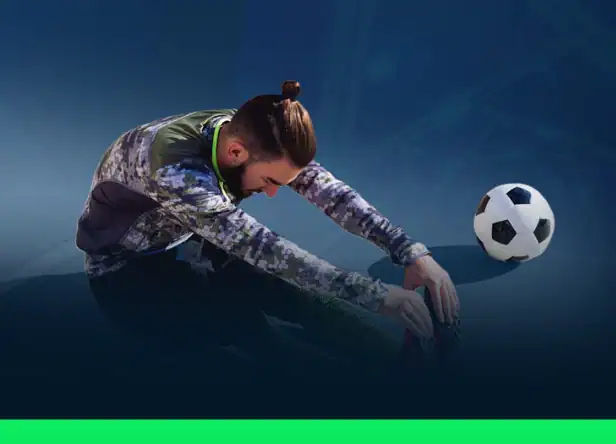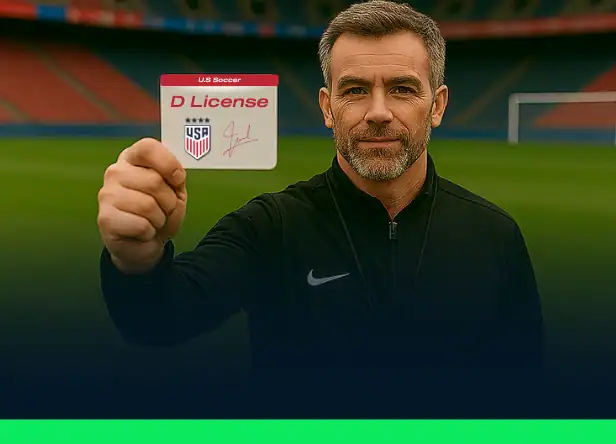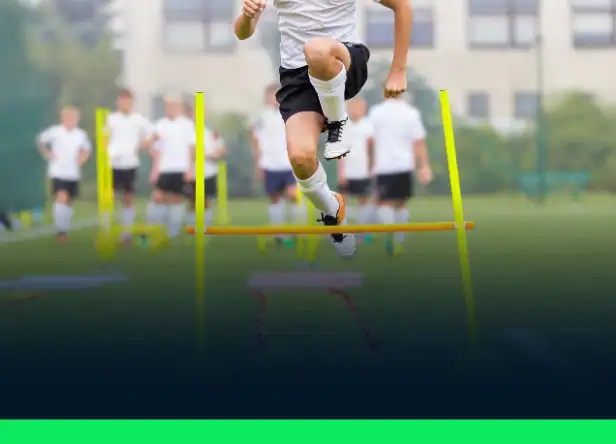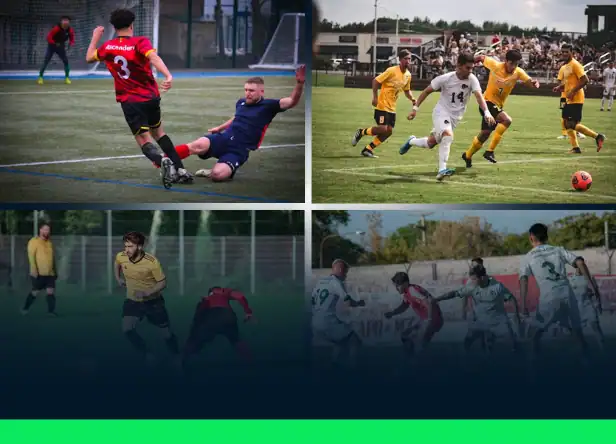This article takes you into the world of free kicks, the laws that regulate them, and the distinction between direct and indirect free kicks. You’ll also learn how teams use these strategic opportunities to score goals and change the course of a soccer game.
What Is a Free Kick?
A free kick is a restart awarded when play is halted for a foul or infringement. It grants the team possession a valuable set-piece opportunity from the spot where the offense occurred. Teams use free kicks to progress upfield, fashion goal-scoring chances, or even deliver a shot directly on target.
Free kicks fall under Law 13 of the Laws of the Game, which outlines:
- The two types of free kicks (Law 13.1).
- The correct procedure (Law 13.2).
- Possible offenses by both teams and resulting sanctions (Law 13.3).
What Is Law 13 in Soccer? Law 13: Free Kicks
Law 13 regulates all free kicks. Key provisions include:
LAW 13
- Quick Free Kick: If the attacking side opts for a rapid restart and an opponent encroaches within 9.15 m (10 yards) but does not deliberately impede play, the referee allows the kick. However, any opponent who intentionally blocks or delays the kick must be cautioned for unsporting behavior.
- Restart Locations:
- Indirect free kicks inside the opponent’s goal area are taken from the closest point on the goal-area line to the infringement.
- Defensive free kicks awarded within the defending goal area may be taken anywhere within that six-yard box.
- If a player enters or leaves the field without permission, the free kick is taken from where the ball was when play stopped. Off-field fouls restart on the nearest boundary line.
- Penalty Kick Exception: Fouls punishable by a direct free kick occurring on the goal line enclosing the penalty area result in a penalty kick.
Ball in Play
The ball must be stationary before the kick, kickers cannot play the ball again until another player touches it, and the ball is in play once kicked and clearly moves.
Opponent Distance
Opponents must remain at least 9.15 m (10 yards) from the ball and the kicker, unless on their own goal line between the posts.
For defensive free kicks inside the penalty area, all opponents must remain outside the penalty box until the kick is taken.
If the defense forms a wall of three or more players, attackers must stand at least 1 m from the wall until the ball is in play.
Feints and Follow-Ups
Players may feint to deceive opponents as part of their kicking approach.
If a kicker plays the ball against an opponent and regains possession without using excessive force or reckless conduct, the referee allows play to continue.
When Is a Free Kick Awarded?
A referee may award a free kick in several situations:
- Foul against a player: When a player commits a foul such as a dangerous tackle, illegal charge, or handball, the referee can award a free kick to the opposing team.
- Unsporting behavior: If a player shows unsporting conduct toward an opponent or referee, a free kick may be given.
- Offside: If a player is in an offside position when receiving the ball, the referee awards a free kick from the location of the offside offense.
- Other infringements: Infractions like dangerous play, obstruction, or any violation of the rules can also lead to a free kick.
How Is a Free Kick Taken?
A free kick is a strategic opportunity for a team to reset play or attempt to score. Here are the main steps:
- Placement of the ball: The ball is placed at the exact spot of the foul. This location determines the nature of the kick.
- Regulatory distance: Opponents must remain at least 9.15 meters (10 yards) away from the ball and the kicker (Law 13).
- Execution: The designated player then decides whether to take a:
- Direct Free Kick: A direct shot on goal. A goal is valid if the ball crosses the line under the crossbar without another touch.
- Indirect Free Kick: The ball must touch another player—via pass, deflection, or buildup—before a goal can be awarded. Goals scored directly from it do not count.
Direct vs. Indirect Free Kicks
| Feature | Direct Free Kick | Indirect Free kick |
|---|---|---|
| Goal Scoring | Can score directly | Must touch another player before entering goal |
| Signal by Referee | Single whistle | Referee raises arm until the kick is taken or ball is out |
| Common Offenses Awarded | Handball, tripping, pushing | Dangerous play, obstruction, offside |
Tactical Importance of Free Kicks
Free kicks are prized tactical weapons. Coaches design set-piece routines to exploit space, target tall players at the near or far post, or unleash long-range specialists. Teams may elect for a short pass to unbalance the defense, a cross into the box, or a direct strike—depending on distance and personnel.
Defensive Wall Strategies
- Wall Formation: Defenders often create a wall of three to five players aligned to block the most dangerous shooting angles.
- Jump and Duck: Coordinated jumps or ducks to obstruct shots aimed over or under the wall.
- Goalkeeper Positioning: The keeper aligns the wall to cover one side, leaving themselves free to react on the other.
The Best Free Kick Takers in Soccer History: Legendary Free Kick Specialists
Over decades, certain players have redefined the art of the free kick by blending precision, power, and spin:
- David Beckham: Renowned for his curling “bend it like Beckham” strikes that curled around walls.
- Juninho Pernambucano: Master of the knuckleball technique, generating unpredictable flight with minimal spin.
- Andrea Pirlo: Exceptional at disguising his intent, orchestrating decoys to free teammates into space.
- Lionel Messi: Expert at curling low, driven kicks around walls from outside the box.
- Cristiano Ronaldo: Famous for his “knuckleball” and powerful long-range attempts with relentless power.
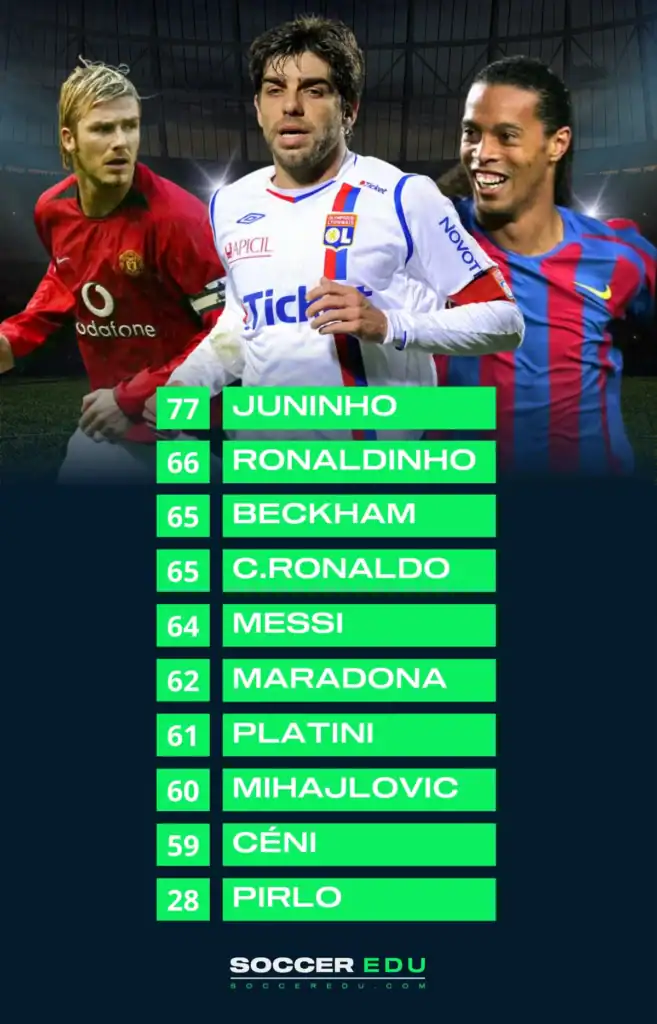
What’s the Difference Between a Free Kick, a Corner Kick, and a Penalty Kick?
Free Kick vs. Corner Kick vs. Penalty Kick: What are the main differences? Understanding other set-pieces clarifies the unique role of free kicks:
| Set-Piece | Location | Scoring Opportunity |
|---|---|---|
| Free Kick | Spot of a foul, usually outside penalty area | Direct or indirect strike, creative plays |
| Corner Kick | Nearest corner arc when ball crosses line by defender | Typically aimed into penalty area for headers or volleys |
| Penalty | Penalty spot, 12 yards from goal line | Direct shot on goal, only goalkeeper defends |
Variations and Innovations
Teams continually innovate around free kicks:
- “Under-the-Wall” Shots: Low drives under wall jump.
- Dummy Runs: Attacking players sprint through the wall to drag defenders.
- Teammate Screens: Players block the goalkeeper’s line of sight at the last moment.
- Short Lay-offs: Tapping to a teammate behind or beside the wall for a crafted pass.
- Hybrid Routines: Combining indirect free-kick setups with direct threats for confusion.
Training Tips for Free Kicks
Players can elevate their free-kick prowess by focusing on:
- Technique Drills: Repetition of both curling and driven shots from varied distances and angles.
- Wall Placement Practice: Simulating competition conditions with varied wall depths and heights.
- Visual Cues: Identifying reference marks on the pitch (e.g., penalty box edge) for consistent alignment.
- Mental Rehearsal: Visualizing different scenarios—wall jump timing, keeper’s movement, and wind conditions.
- Fitness Components: Flexibility exercises for ankle and hip to generate optimal spin and power.
Conclusion: Main Takeaway
Free kicks remain one of soccer’s most thrilling features, combining individual skill with team strategy. Mastery of set pieces often separates the good teams from the great—and can decide the outcome of high-stakes matches. With both the historical greats as inspiration and modern innovations, teams will continue to refine free-kick techniques, ensuring this set piece retains its place as a defining aspect of the beautiful game.


